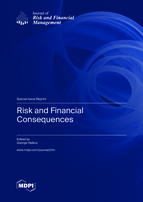Risk and Financial Consequences
A special issue of Journal of Risk and Financial Management (ISSN 1911-8074). This special issue belongs to the section "Risk".
Deadline for manuscript submissions: closed (31 January 2023) | Viewed by 71230
Special Issue Editor
Interests: applied statistics and econometrics; simulations of economic modelling; environmental economics; applied micro-economic with emphasis in welfare economics; air pollution; game theory; mathematical models (non-linear programming)
Special Issues, Collections and Topics in MDPI journals
Special Issue Information
Dear Colleagues,
Risk is a term that exists in everyone’s life, not only when an unexpected event occurs but in any decision someone has to make. Among those studying or working in the financial sector, there is a well-spread knowledge regarding the rational investor’s preferences. Regardless of the business sector they will choose to invest in, investors’ main goal is to maximize their profits. For that reason, investors are characterized in literature as “risk averters”. Hedging and portfolio diversification may appear to be efficient in reducing the potential loss of an investment. Great attention has been drawn to the advantages of portfolio diversification, while researchers have mentioned the ability of transferring the risk of investment through hedging, underlying that the size of the optimal hedging ratio is one of the main determinants used by decision makers apart from the cash position of the corporation. However, there are some cases which cannot be predicted. Society, which includes nature’s actions and human activities, is characterized by vulnerability and rapid changes. Nature acts independently, and a common example of that independence is tectonic plate movement. Thus, natural actions that cannot be predicted may cause significant losses, both economic and life-related. Economic losses can be due to many factors, such as the partial or total destruction of homes or business premises that will lead to reduced, if not zero, productivity. In the case of businesses, reduced productivity may affect investors’ perceptions, causing fluctuations in the share price or even volatility in the board of directors. Although disasters are associated with risk, investors tend to have a different perspective depending on the source of the disaster. More specifically, if a country is facing a natural disaster, where no one can be blamed, the foreign investors who may hold this country’s bonds will continue to trust the country due to the “innocence” of the country. On the other hand, when a firm causes a technological disaster, such as a nuclear power plant explosion, investors, if this corporation is publicly traded, will “punish” the firm by selling its shares at any price to avoid a bigger loss. Even if we exclude the case of an industrial accident, a possible excess pollution caused through production may lead to adverse publicity for the corporation. Another important issue that may have an impact on investors’ psychology can be political strategies or actions, announcements as well as extreme behaviors, such as terrorist attacks. Those cases not only increase the risk of the citizens of the regions facing those political scenarios but also that on the markets and affecting investors’ decisions. With these in mind, managing risk is an important executive responsibility for corporations and governments. Reputations which may take decades to build can be destroyed in hours or even seconds through decisions, announcements or accidents. Corporate social responsibility (CSR) is an “instrument” that has the potential to reduce these risks. Moreover, shareholders and investors, through socially responsible investing (SRI), tend to use their capital to encourage behaviors they consider responsible. In addition, due to the great attention on climate change globally, eco-friendly investments are made in an attempt to reduce pollution and the general environmental impact. Apart from the CSR strategies that corporations may follow, ISO and IMAS certifications owned by firms appear to create a more reliable environment between corporates, clients, and possible investors due to the fulfillment of the required international standards.
Prof. Dr. George Halkos
Guest Editor
Manuscript Submission Information
Manuscripts should be submitted online at www.mdpi.com by registering and logging in to this website. Once you are registered, click here to go to the submission form. Manuscripts can be submitted until the deadline. All submissions that pass pre-check are peer-reviewed. Accepted papers will be published continuously in the journal (as soon as accepted) and will be listed together on the special issue website. Research articles, review articles as well as short communications are invited. For planned papers, a title and short abstract (about 100 words) can be sent to the Editorial Office for announcement on this website.
Submitted manuscripts should not have been published previously, nor be under consideration for publication elsewhere (except conference proceedings papers). All manuscripts are thoroughly refereed through a single-blind peer-review process. A guide for authors and other relevant information for submission of manuscripts is available on the Instructions for Authors page. Journal of Risk and Financial Management is an international peer-reviewed open access monthly journal published by MDPI.
Please visit the Instructions for Authors page before submitting a manuscript. The Article Processing Charge (APC) for publication in this open access journal is 1400 CHF (Swiss Francs). Submitted papers should be well formatted and use good English. Authors may use MDPI's English editing service prior to publication or during author revisions.
Keywords
- risk and green energy finance
- risks and energy crisis
- unexpected events
- risk
- uncertainty
- CSR
- panel data analysis
- applied econometrics
- applied statistics
- hedging
- risk of investment





